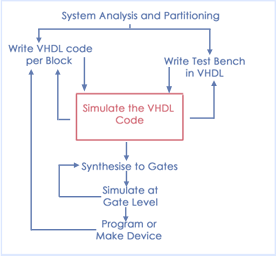Home »
Full Forms »
Technology Full Forms
What is the full form of VHDL?
Full form of VHDL: Here, we are going to learn about the VHDL, full form of VHDL, overview, history, advantages, disadvantages, etc.
By Anushree Goswami Last updated : March 30, 2024
VHDL: VHSIC (Very High Speed Integrated Circuit) Hardware Description Language
VHDL is an abbreviation of VHSIC Hardware Description Language in which VHSIC stands for Very High-Speed Integrated Circuit. VHDL is a language of hardware description that is used to create a model of physical hardware used in logic circuits like digital systems to appraise their arrangement, timing, and activities. It is not supposed to be bewildered with a programming language as it is not a programming language. In VHDL, a user can also define its data type and also apart from that there are some predefined data types in VHDL.
History of VHDL
- In 1981, it was initially created by the U.S. Department of Defense.
- In June 2006, the so-called Draft 3.0 of VHDL-2006 was officially permitted by the VHDL Technical Committee of Accellera. This projected standard makes available for the use of various extensions that make the writing and arranging VHDL code simpler, at the same time cause to continue complete compatibility with the older versions also.
- In February 2008, VHDL 4.0 was officially permitted by Accellera which is also unofficially known as VHDL 2008.
- In 2008, for addition to IEEE 1076-2008, Accellera launched VHDL 4.0 to the IEEE for balloting.
- In January 2009, the VHDL standard IEEE 1076-2008 was published.

Image source: https://www.doulos.com/knowhow/vhdl_designers_guide/design_flow_using_vhdl/
Why Use VHDL?
- It will proficiently enhance the efficiency if used in an appropriate mode and organized approach.
- It provides an advantage to use again a code as stated by the use of the user.
- As electronic tools are enhancing and developing quickly, a user can shift to further highly developed tools by using VHDL.
Advantages of VHDL
- It has implementable features.
- In the context of the system, it has authenticated specifications or Subcontracts.
- Its functionality is apart from execution.
- It imitates early and handles complications fast.
- It discovers design substitutes.
- It manufactures improved designs.
- It has automatic synthesis and test generation (ATPG for ASICs).
- It enhances efficiency and productivity by cutting down the time-to-market.
- Its technology and tools are independent as however FPGA specifications may be unexploited.
- It has transferable design data to look after investment.
Disadvantages of VHDL
- It is a huge and complicated language and this is the reason it is difficult to learn and its execution is not simple.
- In comparison to other tools, tools used in VHDL are expensive.
- It does not make available for use all kinds of features of the technology.
Advertisement
Advertisement